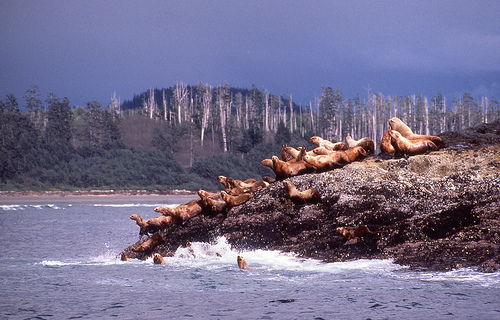I usually return tired, but happy, after my shift as a docent at the Pacific Marine Mammal Center in Laguna Beach. But today was different. I returned home even more tired than usual, but also very sad. Although the beautiful southern California spring weather was gentle and kind, the pathetically thin bodies of a very high number of sea lion pups struggling to hang onto life was depressing.
Usually sea lion pups are being weaned by their mothers eight to 12 months after their births in the summer. Although most do fine, some need temporary help to acclimate to life and fishing for themselves without mom. We are used to this pattern. But this year in southern California is different. Why? The best guess from the experts is that the fish weren't where they used to be. The mothers have had to go out farther and farther to find the fish, leaving their young pups for longer periods of time, feeding them less often, and then weaning their pups too early. Warmer waters than usual had made the fish seek cooler water — away from the sea lion moms and their babies.
The result has been an unending stream of emaciated sea lion pups coming onto the beaches because they have no body fat to help them tolerate the cold southern California sea. We now have had 12 or more rescues on some days, and the outdoor pens, as well as the heated indoor pens, are filling up rapidly. Our staff and over 80 volunteers are coming in more often, and staying longer hoping to save as many as possible.
The community is helping with this unprecedented challenge by donating money and bringing in supplies, such as Pedialyte used in the formulas that are fed to those too weak to eat fish. It is heartening to see how much the public cares about these wild animals when they see the protruding ribs and folds of skin showing starvation. But I can't help thinking that this year's tragedy is linked to the human contribution to climate change, overfishing and how we've polluted the seas we used to consider abundant and too big to change.
The sea lions that have been treated for a while show progress. Just looking in the pens with sea lions that have been at the center for a while clearly shows the difference food makes. When I point out to visitors that the sea lions that are twice the weight, active, and playful are the same age as the tiny, weak ones, they understand better just how much most of the pups are suffering.
I have been a volunteer docent for 12 years, and have seen other crises over the years from other reasons. I have also seen very sick marine mammals transformed with care into happy, active, normal animals. I feel very good about the work our center and volunteers are committed to doing. But this year tops them all for the large numbers of sea lion pups in dire distress. Is this a very troubling sign for future generations of sea lion pups?
As sometimes happens when confronted with large numbers of sufferers, my eyes focused on one scrawny pup on his stomach with a little flipper spread out to each side. He looked desperately tired, but was soaking up as much sun as he could. Good luck, little one.









